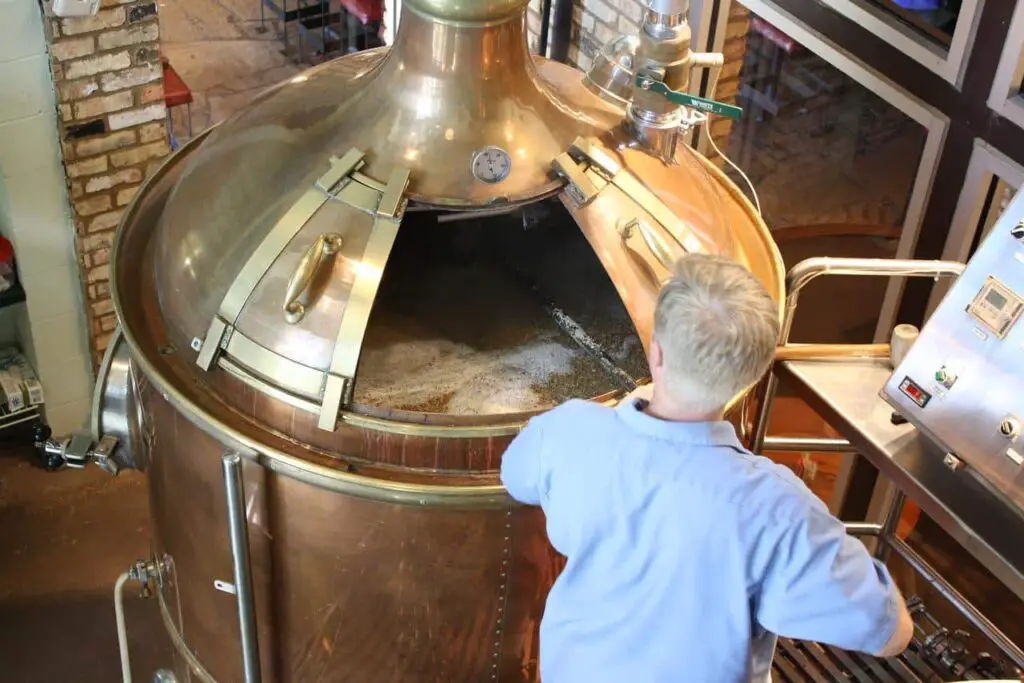If you buy something through a link in our posts, we may get a small share of the sale.
Batch sparging is rinsing the mash with water to collect the fermentable sugars. All-grain brewers often use this process to simplify the brewing process or improve efficiency. Therefore, understanding how to batch sparge will help any all-grain brewer to enhance the brewing process and the final product.
Contents
How to Batch Sparge
The best and easiest way to batch sparge is to slowly add the sparge water to the mash tun while stirring. Continue to stir until the water is evenly mixed with the grain. Then, let the mixture stand for a few minutes to allow the grain to settle. After a few minutes, slowly drain the wort into the boil kettle.

Add boiling water to the top of the grains again, then drain that liquid into the brew kettle. The objective is to rinse all of the fermentable sugars from the grain into your brew kettle. Next, you will need to boil the wort and add hops according to your recipe. This way, you will have a nice, even batch of wort ready to be fermented.
There are a few things to keep in mind when batch sparging. First, you want to avoid compacting the grain bed. Second, The temperature of the mashout should range from 168-170 degrees F. This will help to improve efficiency and prevent clogging. Finally, give the grain bed a good stir before adding the sparge water to distribute the water and avoid compacting the grain bed evenly.
Step by Step Guide to Batch Sparging
Sparging is a delicate process that requires precision and practice to perfect. You don’t want to compact the grain bed since this will make it harder to extract the fermentable sugars. The following is a step-by-step guide on how to carry out the process:
Step 1: Assemble Your Equipment
The first step is ensuring you have all the necessary equipment. This will give you a lee-way to avoid any stressful surprises during the brewing process. The list below is a general overview of what you’ll need:
- Mash tun with a false bottom: This will be used to hold the grain while you sparge.
- Boil kettle: This is where you will collect the wort (unfermented beer). It is important to have a large kettle to hold all the wort.
- Sparge water: This is clean, hot water used to rinse the grain.
- A thermometer: This is used to monitor the temperature of the mash and ensure it doesn’t exceed 170 degrees F.
- A heat-proof container: This is used to hold the sparge water while it’s heating up.
Step 2: Mash the Grains
To have a successful batch sparge, you must start with a well-mashed grain. This will ensure all the enzymes are active and ready to break down the starches into fermentable sugars. It also provides that you have a consistent mash temperature throughout the process. The ideal temperature for mashing is between 154-158 degrees F.
To mash the grain, start heating the strike water to the desired temperature. Then, add the grain and stir until it is all wet.
Once the grain is added, check the temperature and make sure it is in the right range. Then, put a lid on the mash tun and let it sit for 60 minutes to allow the enzymes to do their work.

Step 3: Heat the Sparge Water
While the mash is going on, it’s time to heat the sparge water. The water should be heated to about 168-170 degrees F. This temperature is important because it helps improve the process’s efficiency and prevents clogging.
Also, ensure enough sparge water to cover the grain by an inch or two. This will help ensure all the fermentable sugars are rinsed from the grain. You don’t want to skimp on the sparge water since this will impact the efficiency and quality of the final product.
Step 4: Recirculate Your Wort
Before you start the sparge, it’s important to recirculate your wort. This will help clear the wort of debris and ensure a clear final product. To recirculate the wort, slowly run it through a strainer back into the mash tun. Be sure to do this slowly to avoid compacting the grain bed.
Next, open the valve and let the wort flow into the boil kettle. Then, close the valve and repeat the process until the wort is clear. You don’t want to overdo it since this will cause the grain bed to compact.
Step 5: Start the Sparge
Once you have recirculated the wort, it’s time to start the sparge. Ensure you have hot water ready to go and that the mash tun is free of debris. Then, slowly add the sparge water to the grain bed while stirring. Be sure to add the water evenly to avoid compacting the grain bed.
There is a way to determine the amount of water you need to add. The runoff volumes from your mash and batch sparge should be about the same. This will help ensure all the fermentable sugars are extracted from the grain.
The formula to determine how much water you need is R1 + W + S1 + S2…+ S(X) = V, where:
- R1 = The volume of run-off from your mash
- W = The water you add to the kettle during the sparge
- S1 = The first batch sparge
- S2 = The second batch sparge
- V = The final volume of wort in your kettle
Step 6: Boil and Chill the Wort
Once you have collected all the wort, it’s time to start boiling. The boil is important because it helps sanitize the wort and extract flavors from the hops. You will also add other ingredients, such as fruit or spices, at this stage.
The boil should last for 60 minutes. This time is important because it allows the wort to reach a consistent temperature and prevent scorching.
After the boil, it’s time to chill the wort. This can be done by adding it to an ice bath or using a wort chiller. Chill the wort until it reaches 70 degrees F or below. This will help ensure the yeast is healthy and prevent off-flavors in the final product.

Step 7: Transfer to a Fermenter
Once the wort is chilled, it’s time to transfer it to a fermenter. Ensure the fermenter is clean and sanitized before adding the wort. This will help prevent bacteria and wild yeast from contaminating the batch.
Once the wort is in the fermenter, add the yeast. Then, seal the fermenter and wait for the fermentation process to complete. This will take anywhere from 7-14 days. That is it! You have now learned how to batch sparge and brew your own beer.
Frequently Asked Questions
How Do You Sparge Properly?
To sparge properly, drain the wort from the mash tun into the boil kettle. Then, add hot water to the mash tun and stir. Let it sit for 20 minutes, then drain the wort into the boil kettle. Repeat this process until you have collected all the wort.
What Is the Purpose of Sparging?
The purpose of sparging is to extract as much sugar as possible from the grain. By rinsing the grains with hot water, you dissolve and remove the sugar extracted during the mash. It also helps to remove any residual grain husks and debris that may have been left behind.
Conclusion
Sparging is an essential step in the brewing process. It extracts sugars from the grain and removes residual husks. It will produce a clear, flavorful batch of beer when done properly. Sparging also allows you to collect all the wort from the mash tun, so none of it is wasted.

